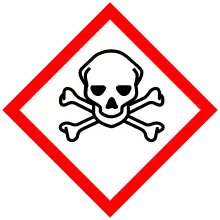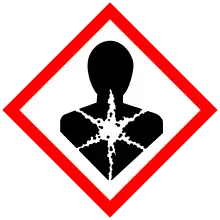 | |
| Names | |
|---|---|
| Preferred IUPAC name
1,3-Dichloropropan-2-ol | |
| Other names
1,3-Dichloropropanol-2; 1,3-Dichloroisopropyl alcohol; 1,3-Dichloro-2-propanol; 1,3-Dichloroisopropanol; Glycerol-α,γ-dichlorohydrin; α-Dichlorohydrin; 1,3-DCP; DC2P | |
| Identifiers | |
3D model (JSmol) |
|
| ChEBI | |
| ChEMBL | |
| ChemSpider | |
| ECHA InfoCard | 100.002.266 |
| EC Number |
|
| KEGG | |
PubChem CID |
|
| RTECS number |
|
| UNII | |
| UN number | 2750 |
CompTox Dashboard (EPA) |
|
| |
| |
| Properties | |
| C3H6Cl2O | |
| Molar mass | 128.98 g·mol−1 |
| Appearance | Colorless liquid[1] |
| Odor | Phenol-like[1] |
| Density | 1.39 g/cm3 (20 °C)[1] |
| Melting point | −4 °C (25 °F; 269 K)[1] |
| Boiling point | 175 °C (347 °F; 448 K)[1] |
| 110 g/L (20 °C)[1] | |
| Hazards | |
| GHS labelling: | |
   | |
| Danger | |
| H301, H311, H312, H336, H350, H370, H373 | |
| P201, P202, P260, P261, P264, P270, P271, P280, P281, P301+P310, P302+P352, P304+P340, P307+P311, P308+P313, P312, P314, P321, P322, P330, P361, P363, P403+P233, P405, P501 | |
| Flash point | 74 °C (165 °F; 347 K)[1] |
| Lethal dose or concentration (LD, LC): | |
LD50 (median dose) |
110 mg/kg (oral, rat)[1] 1080 mg/kg (dermal, rabbit)[1] |
Except where otherwise noted, data are given for materials in their standard state (at 25 °C [77 °F], 100 kPa).
Infobox references | |
1,3-Dichloropropan-2-ol (1,3-DCP) is an organic compound with the formula HOCH2CHClCH2Cl. It is a colorless liquid. It is an intermediate in the production of epichlorohydrin.[2][3]
1,3-DCP is a believed to be a carcinogen and mutagen.[4] The International Agency for Research on Cancer classifies it as a Group 2B carcinogen ("possibly carcinogenic to humans").[5]
Along with 3-monochloropropane-1,2-diol (3-MCPD), 1,3-DCP is found in some Asian style sauces such as soy sauce and oyster sauce.[6][7][8]
References
- 1 2 3 4 5 6 7 8 9 Record in the GESTIS Substance Database of the Institute for Occupational Safety and Health
- ↑ "1,3-Dichloro-2-propanol". Some Chemicals Present in Industrial and Consumer Products, Food and Drinking-Water. International Agency for Research on Cancer. 2013.
- ↑ Howard, Philip H.; Muir, Derek C. G. (2010). "Identifying New Persistent and Bioaccumulative Organics Among Chemicals in Commerce". Environmental Science & Technology. 44 (7): 2277–2285. Bibcode:2010EnST...44.2277H. doi:10.1021/es903383a. PMID 20163179.
- ↑ "Evidence on the Carcinogenicity of 1,3-Dichloro-2-Propanol (1,3-DCP; α,γ-Dichlorohydrin)" (PDF). Reproductive and Cancer Hazard Assessment Branch Office of Environmental Health Hazard Assessment, California Environmental Protection Agency. June 2010.
- ↑ "List of Classifications". International Agency for Research on Cancer.
- ↑ Genualdi, Susan; Nyman, Patricia; Dejager, Lowri (2017). "Simultaneous Analysis of 3-MCPD and 1,3-DCP in Asian Style Sauces Using QuEChERS Extraction and Gas Chromatography–Triple Quadrupole Mass Spectrometry". Journal of Agricultural and Food Chemistry. 65 (4): 981–985. doi:10.1021/acs.jafc.6b05051. PMC 5450852. PMID 28064506.
- ↑ Crews, C; Lebrun, G; Brereton, P. A (2002). "Determination of 1,3-dichloropropanol in soy sauces by automated headspace gas chromatography-mass spectrometry". Food Additives and Contaminants. 19 (4): 343–349. doi:10.1080/02652030110098580. PMID 11962691. S2CID 28748623.
- ↑ Lee, Bai Qin; Khor, Sook Mei (2015). "3-Chloropropane-1,2-diol (3-MCPD) in Soy Sauce: A Review on the Formation, Reduction, and Detection of This Potential Carcinogen" (PDF). Comprehensive Reviews in Food Science and Food Safety. 14 (1): 48–66. doi:10.1111/1541-4337.12120. PMID 33401813.
This article is issued from Wikipedia. The text is licensed under Creative Commons - Attribution - Sharealike. Additional terms may apply for the media files.